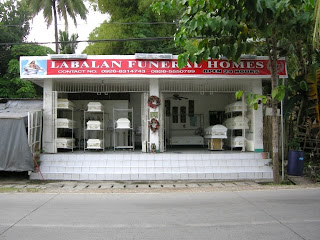
Perhaps I have dwelt too much on the negative. The Philippines can be lovely. Taken some years ago, below is a bay, where I used to scuba dive, on the island of Leyte.
This film snap is of a carabao or water buffalo, also on Leyte.
Here - on film - are traditional houses in Maasin, a town in Southern Leyte.
Although in love with noise, Filipinos are also fond of something more to my taste - colour. The ‘jeepney’, descendant of the wartime American jeep, combines noise and colour. And some fairly frightening driving.
Filipinos have an ambivalent relationship with their former colonial masters. But they’re certainly grateful for liberation from the Japanese. At an impressive monument, General MacArthur returns to the Philippines.
Quite by accident, on a back country road, we stumbled on the spot Japanese forces on Cebu surrendered.
Farmers plow where the last fighting took place.
Language in the Philippines is a delight. I’ve already mentioned the Chocolate Hills. ‘Cake Me Home’ is a bakery near Gord’s and below is a street in Cebu.
A sign I’m sorry not to have taken at the time stands on one of Cebu's main streets - ‘Welcome to the City of the Dancing Tax Collectors’.
Speaking of streets, and, no surprise in a poor, tropical country, life is lived on the street.
At this funeral home, by the side of a northern Cebu road, you could virtually toss granddad from the back of a jeepney into his coffin.
Granddad’s funeral will most likely be in a Catholic church. Religion is central in the Philippines. Even on the ferry to the island of Bohol, there was a prerecorded prayer for safe passage as we left Cebu. Not a bad idea in a country where there are frequent shipping mishaps.
Here’s a little roadside shrine.
This cross is outside Cebu’s basilica. It is claimed to contain pieces of the cross Magellan planted when he landed in the Philippines in 1521.
But this Buddhist temple overlooking Cebu illustrates one of the things I like best about the Philippines, its tolerance.
A mainly Christian people, albeit with a large Muslim minority and insurgency, Filipinos are quite accepting of minorities. This is especially marked in the acceptance of gays, surprising in an often backward place with a highly conservative, Spanish heritage. It speaks well of the Philippines.
_________________________________________________
Twenty-four hours later, Gord and I were unexpectedly headed for the airport as it was clear Gord needed medical care and it was best to have that in Canada. We got home safely and, as I write this in Toronto, he’s getting the appropriate treatment.












































